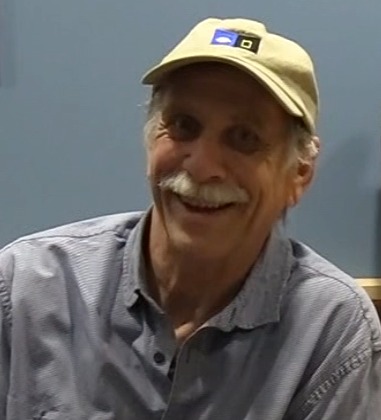Dublin Core
Title
John Graham Oral History Interview
Description
In this interview, John Graham discusses his career in agriculture and his work with Oregon Tilth. He begins by describing his childhood and introduction to farming, and then recounts his decision to join the Peace Corps, describes his experiences in Costa Rica and the Dominican Republic, and notes the ways in which he was introduced to the organic farming and appropriate technology movements. He likewise describes how he became involved with the Aprovecho Institute in Cottage Grove, Oregon.
Next, Graham details the culture of farming in the 1980s and the slow revolution towards organic farming. He also describes the Eugene organic agriculture community and his involvement in Oregon Tilth, and his work for a small local farmers co-op selling organic produce to stores in Eugene. From there, Graham reminisces about his childhood friends, and how so few of the people from Oklahoma have left the state. He moves on to describe the evolution of the certification program within Oregon Tilth and the many agriculture-related legislative acts that were passed in the late 1980s and early 1990s, in particular the Agriculture Productivity Act of 1990. He also discusses the influences that lead him to environmentalism, and biodynamic and organic farming.
Graham then discusses his involvement in the founding of the Eugene Farmers Market, and describes the struggles of growing the market to meet the increasing demand for organic produce. Graham also recalls meeting Masanobu Fukuoka, the author of The One-Straw Revolution, a book that had a powerful influence on him. Next, he describes his time in Mexico as an agriculture inspector, and the challenges that Mexican farmers face to get certified. Graham concludes the interview by sharing what he thinks of the future of farming and mentions how he used to use his artistic skills to design logos for farmers.
John Graham was born in 1954 in the panhandle of Oklahoma, and started driving tractors at the age of 12. He attended University of Oklahoma and then joined the Peace Corps, where learned more about agriculture and met his wife. After five years in the Peace Corps, he moved to England and studied biodynamic farming. While there, he learned about the Aprovecho Institute in Cottage Grove, Oregon, and subsequently moved there. Once in Oregon, he became involved with the local organic agriculture community, starting a small farmer’s co-operative, certifying organic farms, helping to found the Eugene Farmers Market, and editing the Oregon Tilth newsletter.
Through his work with organic certification, Graham, along with Pete Gonzalves, was one of the first inspectors to go to Mexico; he later moved to there and worked as a consultant with a cooperative of farmers in Los Cabos. In addition to his work in agriculture, Graham has attended art classes at the University of Oregon and used those skills to local farmers in their marketing efforts.
Next, Graham details the culture of farming in the 1980s and the slow revolution towards organic farming. He also describes the Eugene organic agriculture community and his involvement in Oregon Tilth, and his work for a small local farmers co-op selling organic produce to stores in Eugene. From there, Graham reminisces about his childhood friends, and how so few of the people from Oklahoma have left the state. He moves on to describe the evolution of the certification program within Oregon Tilth and the many agriculture-related legislative acts that were passed in the late 1980s and early 1990s, in particular the Agriculture Productivity Act of 1990. He also discusses the influences that lead him to environmentalism, and biodynamic and organic farming.
Graham then discusses his involvement in the founding of the Eugene Farmers Market, and describes the struggles of growing the market to meet the increasing demand for organic produce. Graham also recalls meeting Masanobu Fukuoka, the author of The One-Straw Revolution, a book that had a powerful influence on him. Next, he describes his time in Mexico as an agriculture inspector, and the challenges that Mexican farmers face to get certified. Graham concludes the interview by sharing what he thinks of the future of farming and mentions how he used to use his artistic skills to design logos for farmers.
John Graham was born in 1954 in the panhandle of Oklahoma, and started driving tractors at the age of 12. He attended University of Oklahoma and then joined the Peace Corps, where learned more about agriculture and met his wife. After five years in the Peace Corps, he moved to England and studied biodynamic farming. While there, he learned about the Aprovecho Institute in Cottage Grove, Oregon, and subsequently moved there. Once in Oregon, he became involved with the local organic agriculture community, starting a small farmer’s co-operative, certifying organic farms, helping to found the Eugene Farmers Market, and editing the Oregon Tilth newsletter.
Through his work with organic certification, Graham, along with Pete Gonzalves, was one of the first inspectors to go to Mexico; he later moved to there and worked as a consultant with a cooperative of farmers in Los Cabos. In addition to his work in agriculture, Graham has attended art classes at the University of Oregon and used those skills to local farmers in their marketing efforts.
Creator
John Graham
Source
Oregon Tilth Oral History Collection (OH 40)
Publisher
Special Collections and Archives Research Center, Oregon State University Libraries
Date
February 14, 2018
Contributor
Tiah Edmunson-Morton and Carl Berg
Format
Born Digital Video
Language
English
Type
Oral History
Identifier
oh40-graham-john-20180214
Oral History Item Type Metadata
Interviewer
Tiah Edmunson-Morton
Interviewee
John Graham
Location
The Valley Library, Oregon State University
Original Format
Born Digital Video
Duration
1:56:51
OHMS Object
Interview Format
video
